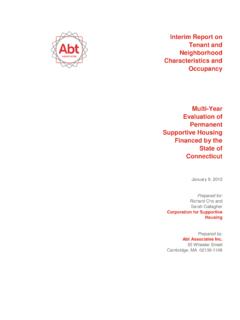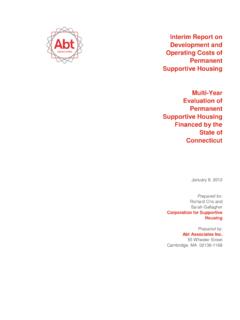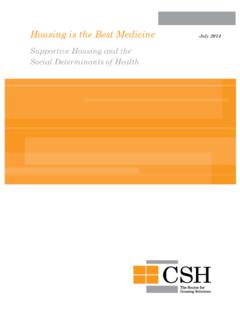Transcription of Financing Supportive Housing with Tax-Exempt …
1 October 2007 Financing Supportive Housing with Tax-Exempt Bonds and 4% Low-Income Housing Tax Credits Prepared by Joe Biber, in collaboration with CSH s Project Development and Finance Team. About the Author Joseph Biber is a Housing and development consultant to non-profit organizations principally in New York City, with a particular focus on permanent Supportive Housing development. He has been actively involved in the development of Housing for low-income and special needs populations since 1979. His professional experience encompasses working for the New York City Department of Housing Preservation and Development, The Enterprise Foundation and the Community Services Society of New York (CSS).
2 While directing the Shelter Development Project at CSS, Joseph Biber headed-up a development team that pioneered some of earliest Supportive Housing projects in the country. Mr. Biber holds a Master s Degree in City and Regional Planning from the University of North Carolina at Chapel Hill. Inquiries If you are interested in developing a Supportive Housing project, please see for additional on-line resources and materials, including information regarding the communities in which we currently work. If you have questions or comments regarding this publication, please contact the CSH Resource Center at This publication is available to download for free at CSH provides technical assistance through its local and regional offices, and may be able to advise interested public agencies.
3 For example, CSH was instrumental in the design and implementation of the New York State Office of Mental Health s bond/tax credit Financing initiative and plays on ongoing role in assisting project sponsors with technical and predevelopment loan support. CSH identified the key players, convened meetings with these agencies, and engaged consultants, attorneys and tax credit investors to assist in the design of the program. For more information, please feel free to contact Brigitt Jandreau-Smith, Managing Director, Project Development & Finance, at The Corporation for Supportive Housing (CSH) is a national, nonprofit organization that helps communities create permanent Housing with services to prevent and end homelessness.
4 CSH advances its mission by providing high-quality advice and development expertise, by making loans and grants to Supportive Housing sponsors, by strengthening the Supportive Housing industry, and by reforming public policy to make it easier to create and operate Supportive Housing . CSH delivers its core services primarily in ten states (California, Connecticut, Illinois, Indiana, Michigan, Ohio, Minnesota, New Jersey, New York, Rhode Island) and in Washington, DC. CSH also operates targeted initiatives in 6 states (Indiana, Kentucky, Maine, Massachusetts, Oregon, and Washington) and provides limited assistance to many other communities. We encourage nonprofit organizations and government agencies to freely reproduce and share the information from CSH publications.
5 The organizations must cite CSH as the source and include a statement that the full document is posted on our website, Permissions requests from other types of organizations will be considered on a case-by-case basis; please forward these requests to Information provided in this publication is suggestive only and is not legal advice. Readers should consult their government program representative and legal counsel for specific issues of concern and to receive proper legal opinion regarding any course of action. 2007 Corporation for Supportive Housing Table of Contents Background on Tax-Exempt Bonds and 4% Tax Credits ..Page 2 Tax-Exempt Bonds and 4% Low-income Housing Tax 2 Requirements for Tax-Exempt Bonds and Tax Credits for Supportive Housing .
6 Page 3 Comparison of the Different Project Financing Models ..Page 4 Benefits to State or Local Governments Using Bond and Tax Credit Financing for Supportive 5 Availability and Access to Tax-Exempt Bonds ..Page 5 Complementary Financing and Ineligible Financing ..Page 6 4% Credits versus 9% 6 Advancing Tax-Exempt Bond and 4% Credits Financing Models at State or City Agencies ..Page 7 Further 9 Financing Models Case Studies .. Pages 10 - 21 Case Study #1: Financing Model Using Bonds Only During Construction (State of Ohio) Case Study #2: Financing Model Using Bonds Only During Construction (City of New York) Case Study #3: Financing Model Using Bonds Only During Construction (State of California) Case Study #4: Financing Model Using Bonds During Construction and for Permanent Financing (State of Michigan) Case Study #5: Financing Model Using Bonds During Construction and for Permanent Financing with Prepayment (State of New Jersey) Case Study #6.
7 Financing Model Using Bonds During Construction and for Permanent Financing with Debt Service Paid by State Agency (State of New York) Case Study #7: A Hybrid Financing Model (State of Illinois/City of Chicago) Corporation for Supportive Housing : Financing Supportive Housing with Tax-Exempt Bonds and 4% Low-Income Housing Tax Credits 1 Background on Tax-Exempt Bonds and 4% Tax Credits Tax-Exempt bonds partnered with 4% Low-income Housing Tax Credits (LIHTC) have been widely used by affordable Housing developers. It has taken longer for this Financing structure to be used by permanent Supportive Housing developers since most assume their projects cannot support debt service on the bonds.
8 In recent years, a number of states have devised strategies to address the debt service issue and non-profit sponsors of Supportive Housing have become increasingly sophisticated in the use of these Financing tools. This approach can expand the funding sources available for Supportive Housing , especially in those states and localities lacking dedicated capital programs for Supportive Housing and where competition for every affordable Housing dollar is intense. For those public agencies that are already administering capital development programs, the use of bonds can leverage significant additional equity. In addition, this approach can create rental subsidy and service funding because tax credit equity can be used to fund reserves for these While this Financing technique can be complex and more costly, its benefits generally far outweigh the costs and is showing great potential for the Supportive Housing industry.
9 This report is intended to introduce this technique to local and state officials considering bond Financing , presenting several case studies and answering some of the most commonly asked questions. Tax-Exempt Bonds and 4% Low-income Housing Tax Credits Tax-exempts bonds are debt obligations issued by state or local government agencies for multi-family rental Housing , infrastructure improvements and other qualified municipal endeavors having a public purpose. The IRS Code (Section 103) allows the purchasers of the bonds to deduct the interest income from the bonds from their federal gross income taxes. Thus the interest rate on Tax-Exempt bonds is lower than conventional bank Financing (typically by about 2%), and these savings can promote Housing affordability.
10 Another feature of Tax-Exempt bonds is that they provide as-of-right (non-competitive) 4% Low-income Housing Tax Credits for Housing projects that meet certain requirements. 9% Low-income Housing Tax Credits, which are more commonly used for Supportive Housing , are competitive and limited by the state s allocation. The project equity that can be raised through the tax credits, along with lower interest rates, can be a potent Financing tool for Supportive Housing , where tenants incomes are very low and support limited or no debt. Housing bonds can be Tax-Exempt or taxable. Tax-Exempt bonds have a lower interest rate and come with tax credits, whereas taxable bonds have neither of these advantages.







